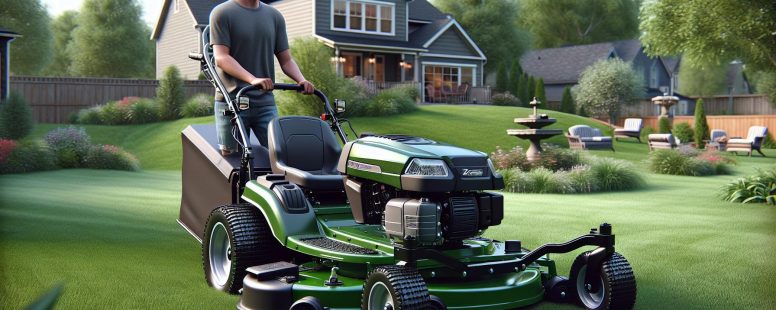Understanding the Weight of a Riding Lawnmower: A Comprehensive Guide for Buyers
Ever found yourself pondering the weight of a riding lawnmower? It’s not an everyday question, but it certainly has its importance. Whether you’re considering buying one for your sprawling lawn or need to transport an existing machine, knowing how much a riding mower weighs can be crucial.
Understanding the Components of a Riding Lawnmower
Grasping the elements that make up your riding lawnmower aids in comprehending its overall weight. Let’s dissect some major components.
The Engine
A key component, and often the heaviest, is the engine. Standard engines for these machines typically range between 15 to 25 horsepower (HP). An average mid-range engine with around 18-20 HP weighs approximately 85 pounds (lbs), but it varies based on design specifications.
| Horsepower | Weight(lbs) |
|---|---|
| <15 | ~75 |
| >25 | ~100+ |
Keep in mind this doesn’t include additional parts such as fuel tanks or batteries which can add an extra few lbs to your machine’s total weight.
The Cutting Deck
Another integral part influencing mower mass is its cutting deck. This component houses one or more sharp blades designed for slicing grass at precise heights determined by you! A typical cutting deck might weigh anywhere from 40 lbs upwards depending upon size and material used — steel decks usually being heavier than their plastic counterparts!
For example:
- Small-sized Decks (~30 inches): Approximate Weight = ~40 -50 lbs
- Medium-sized Decks (~42-46 inches): Approximate Weight = ~80 -90 lbs
- Large-sized Decks (>50 inches): Approximate Weight = +100 lbs
The Chassis
The framework housing all other parts – known as chassis– also contributes significantly towards net lawn mower weight. Its dimensions dictate how much space internal components occupy while simultaneously determining device durability and lifespan.
Remember: Bigger isn’t always better; larger mowers may handle rough terrains effortlessly, yet they’re harder maneuvering through tight spaces due to increased bodyweight—something crucial when operating within small gardens littered obstacles like trees shrubs!
Factors Affecting the Weight of a Riding Lawnmower
Diving deeper into the weight factors, it’s essential to explore two more impactful elements: model variation and feature differences.
Variation in Model and Brand
Model variance plays an integral part in determining lawnmower weight. For instance, consider popular brands like John Deere or Husqvarna. The lightest riding mower from John Deere weighs around 450 pounds while its heaviest counterparts tip the scales at over 800 pounds. Similarly, Husqvarna offers mowers weighing between approximately 420 to over 660 pounds. This disparity isn’t random but relates directly back to specifications such as engine size, deck width, chassis type — each uniquely configured for different models within these brands.
Differences in Extras and Features
Your lawnmower doesn’t just cut grass; modern-day mowers come packed with features contributing significantly towards overall mass too! You’ll find options like added mulching kits or bagging systems that can add anywhere from five up till thirty extra lbs on your machine depending on their quality and complexity.
Also you’ve got high-end comfort additions including plush seats (10-15 lbs), cup holders (<1 lb), larger fuel tanks (2-3 lbs when full) which although small individually do sum up eventually impacting total equipment loadout significantly!
Typical Weight Range for Riding Lawnmowers
Let’s investigate deeper into the typical weight range of riding lawnmowers, with a focus on lighter and heavier models.
Lighter Models
Lighter models are generally easier to handle. They weigh in at around 350 pounds (John Deere D105) or even less than that. Some examples include brands like Snapper RE130 at approximately 336 pounds and Troy-Bilt Pony 42X weighing roughly 520 pounds. These mowers often have smaller cutting decks – usually under forty-two inches wide, contain engines below twenty horsepower, don’t carry excess features such as mulching kits or comfort additions.
These weights aren’t set in stone though; they can vary based on additional specifications including engine size or any extra features you decide to add onto your machine.
Heavier Models
On the other hand, there’re also more robust lawn tractors which pack quite some poundage! For instance: The John Deere X758 tips scales over an impressive thousand-pound mark while Husqvarna’s GTH52XLS weighs close to about seven hundred fifty-five pounds.
The higher end of this spectrum includes commercial-grade zero-turn mowers designed for larger properties and professional landscaping tasks — those bad boys can exceed thirteen hundred lbs!
Remember these figures might fluctuate depending upon added amenities ranging from plush seats enhancing ride comfort right through various feature-packed kits aimed towards boosting mower performance thereby leading them being termed ‘heavy-duty’. Now isn’t it all starting make sense why knowing how much your potential new workhorse could weigh becomes rather crucial?
How to Determine the Weight of Your Riding Lawnmower
After exploring what contributes to a riding lawnmower’s weight and examining how variations affect it, let’s investigate into ways you can ascertain your mower’s precise weight.
Reading the Manufacturer’s Specifications
The most straightforward method is by consulting your lawn mower’s user manual or manufacturer specifications. These documents typically detail all vital statistics about the machine including its total weight (minus fuel). If you’re unable to locate your hardcopy, many manufacturers provide online versions on their official websites.
Remember, this listed figure usually excludes any additional features added after purchase. Items like bagging attachments, mulching kits or comfort add-ons influence overall heft but aren’t accounted for in standard factory measurements.
To obtain accurate data:
- Identify brand and model number.
- Look up relevant information via an authoritative source such as manufacturer website.
- Consider added elements not included in initial specs.
Weighing Your Riding Lawnmower Manually
If there are no available specifics from the maker or if modifications have been made post-purchase impacting mass significantly – fear not! You still have options: get hands-on with some at-home weighing tactics!
Though more labor-intensive than just looking up a digit online, physically weighing affords exactness considering unique additions altering original design parameters:
For residential-use mowers:
- Use household scales; proceed with caution due balancing issues.
- Ensure scales bear appropriate load limit prior starting off – safety first!
Commercial-grade counterparts require industrial-strength solutions given increased dimensions and weights well beyond 1000 pounds range:
- Employ commercial vehicle weigh stations; be mindful operational hours might differ locally.
In both instances remember: Always drain fuel before commencing measurement procedures because gasoline does contribute noticeably towards final readout.
Practical Implications of Riding Lawnmower Weight
The weight of a riding lawnmower has practical implications. It can affect maneuverability and fuel efficiency, which are two essential factors for optimal performance.
Effects on Maneuverability
Maneuvering a heavy-duty riding lawnmower around tight corners or through narrow passages becomes an arduous task. For instance, if you’re handling Husqvarna’s heaviest model weighing over 660 pounds, it might feel like exploring with a small car! The heavier the mower is, the more strength and skill you’ll need to control its movement precisely.
Also, transporting your equipment from one location to another gets trickier as the weight increases. Picture this: moving John Deere’s lightest model at approximately 450 pounds versus their heaviest that exceeds 800 pounds – there’s quite some difference in effort involved!
Also, consider storage constraints too; compact models such as Snapper RE130 that weigh less than 350 pounds would take up significantly less space compared to commercial-grade mowers tipping scales at over 1300 lbs.
Impact on Fuel Efficiency
The connection between lawn mower weight and fuel consumption isn’t rocket science – typically speaking: greater mass equals higher energy usage. If we were talking about cars instead of mowers here — imagine comparing gas mileage between lightweight sports vehicles against massive SUVs? You’d see stark differences indeed!
Other Considerations when Buying a Riding Lawnmower
In the quest for buying an ideal riding lawnmower, understanding its weight is just part of the puzzle. There are other factors you’ll want to consider before making your final decision.
Terrain of Your Lawn
The nature of your lawn’s terrain plays a significant role in determining which type and size of mower will be suitable for maintaining it.
For instance, if you’re dealing with hilly or uneven ground, look into models designed explicitly for such conditions. These mowers come equipped with more powerful engines—typically around 20 horsepower—and larger rear wheels to handle slopes without compromising performance or safety.
On flat terrains though, most standard-size riding mowers can efficiently cut grass without any hassle; they generally have less powerful engines (around 10-15 horsepower) that consume lesser fuel compared to their heavier counterparts built for rough terrains.
You might also take into account obstacles like trees and flower beds on your lawn while choosing a mower model—a zero-turn-radius mower could work wonders here due to its exceptional maneuverability even though being relatively heavy at about 600 pounds average weight!
Size of Your Lawn
Size matters—not only does it affect how long you’ll spend mowing but also what kind and size of machine best suits your needs.
A small-sized yard measuring up to half an acre may not require anything bigger than light-weighted compact models like John Deere D105 weighing nearly 350 pounds—with smaller cutting decks (up-to-42 inches) these prove quite easy-to-handle while providing efficient performance! Plus side? They’re easier on the wallet too!
But let’s say we’re talking big leagues now—large yards spanning over three acres—you’d probably benefit from commercial-grade large deck machines offering greater speed and efficiency even though they weigh significantly higher reaching up-to staggering figures as high as1300 pounds!. An example would be Husqvarna GTH52XLS, which can cover more ground faster due to its wide cutting deck.
Conclusion
So there you have it. The weight of a riding lawnmower can fluctuate significantly, influenced by factors like engine size, cutting deck material and brand variations. Don’t forget about those add-ons too; comfort features and mulching kits will surely bump up the poundage.
Remember though, when choosing your mower don’t let weight be your only guidepost. Consider what kind of terrain you’re dealing with and how much lawn space needs tending to as well. Lighter models may suffice for smaller flat yards while larger uneven terrains might call for heavier-duty mowers even though their heftier weights.
Whether buying or transporting a mower understanding its true mass is key in making an well-informed choice that suits both your garden’s requirements and personal handling abilities – something this article aimed at helping you achieve.
- Decorating Your Backyard with Homemade Birdhouses: Creative Ideas to Attract Birds & Beautify Your Garden - October 3, 2025
- Creating Stepping Stones with Kids: A Fun Backyard Project for Family Bonding and Creativity - October 3, 2025
- Where Can I Sell Pottery Locally? Best Places and Tips for Selling Handmade Ceramics - October 3, 2025




